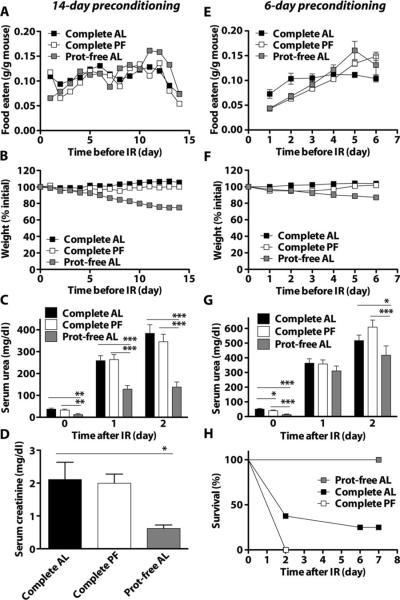Fig. 1.
Protection against renal IR by dietary protein deficiency in the absence of reduced calorie intake.(A to H) Wild-type male B6D2F1 mice were given ad libitum (AL) access to complete or protein (Prot)-free chow, or pair-fed (PF) to the protein-free chow group with complete chow, for 14 days (A to D) or 6 days (E to H) before induction of renal IR injury. (A and E) Body weight of mice expressed as percent initial body weight: (A) n = 9 to 14 per group; (E) n = 12 per group. (B and F) Daily food intake expressed as weight of food eaten per total weight of animals in the cage: (B) n = 2cages per group; (F) n = 3 to 5 cages per group. (C and G) Serum urea on the indicated day before (day 0) or 1 or 2 days after renal IR: (C) n = 7 to 9 per group; (G) n = 7 to 8 per group. (D) Serum creatinine on day 2 after renal IR (n = 3 to 4 per group). (H) Kaplan-Meier survival curves of the indicated groups over 7 days after renal IR (n = 7 to 8 per group). Survival in the protein-free group was significantly improved over both complete diet groups (log-rank test: P = 0.0022 versus AL; P = 0.0001 versus PF). Error bars indicate SEM. Asterisks indicate the significance of the difference between the indicated groups within a given day after IR according to a one-way ANOVA followed by Tukey's multiple comparison test comparing all pairs of values. *P < 0.05; **P < 0.01; ***P < 0.001.

